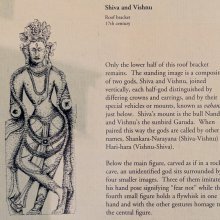Shankaranarayana, Śaṅkaranārāyaṇa, Shankara-narayana: 2 definitions
Introduction:
Shankaranarayana means something in Hinduism, Sanskrit. If you want to know the exact meaning, history, etymology or English translation of this term then check out the descriptions on this page. Add your comment or reference to a book if you want to contribute to this summary article.
The Sanskrit term Śaṅkaranārāyaṇa can be transliterated into English as Sankaranarayana or Shankaranarayana, using the IAST transliteration scheme (?).
Images (photo gallery)
In Hinduism
Shilpashastra (iconography)
Source: Archaeological Survey of India: Śaiva monuments at Paṭṭadakal (śilpa)Śaṅkaranārāyaṇa (शङ्करनारायण) is a sculpture found at the temple of Vijayeśvara, at the southern side, western niche.—By and large this kind of image is called Harihara. But we prefer to term it as Śaṅkara-Nārāyaṇa because, when we read the image, Śiva is to the right and Viṣṇu to the left of the same icon. As the image is rough, probably unfinished, the emblem in Śiva’s right upper hand is not clear and the lower is resting on his lap. The conch held in the left hand of the image helps us to identify the image.

Shilpashastra (शिल्पशास्त्र, śilpaśāstra) represents the ancient Indian science (shastra) of creative arts (shilpa) such as sculpture, iconography and painting. Closely related to Vastushastra (architecture), they often share the same literature.
Languages of India and abroad
Sanskrit dictionary
Source: Cologne Digital Sanskrit Dictionaries: Aufrecht Catalogus CatalogorumŚaṅkaranārāyaṇa (शङ्करनारायण) as mentioned in Aufrecht’s Catalogus Catalogorum:—Rasikāmṛta nāṭaka.
Sanskrit, also spelled संस्कृतम् (saṃskṛtam), is an ancient language of India commonly seen as the grandmother of the Indo-European language family (even English!). Closely allied with Prakrit and Pali, Sanskrit is more exhaustive in both grammar and terms and has the most extensive collection of literature in the world, greatly surpassing its sister-languages Greek and Latin.
See also (Relevant definitions)
Partial matches: Shankara, Narayana.
Starts with: Shankaranarayanamahatmya, Shankaranarayanashtottarashata.
Full-text: Rasikamrita, Harihara, Govindaswami, Bhaskara, Mahesha.
Relevant text
Search found 10 books and stories containing Shankaranarayana, Śaṅkaranārāyaṇa, Shankara-narayana, Śaṅkara-nārāyaṇa, Sankara-narayana, Sankaranarayana; (plurals include: Shankaranarayanas, Śaṅkaranārāyaṇas, narayanas, nārāyaṇas, Sankaranarayanas). You can also click to the full overview containing English textual excerpts. Below are direct links for the most relevant articles:
Sanskrit sources of Kerala history (by Suma Parappattoli)
3. The Laghubhaskariya-Vivarana < [Chapter 6 - Miscellaneous Sanskrit works bearing on Kerala history]
Appendix 1 - Sanskrit Works bearing on Kerala History
16. Yamaka poems of Vasudeva < [Chapter 6 - Miscellaneous Sanskrit works bearing on Kerala history]
Expiatory Rites in Keralite Tantra (by T. S. Syamkumar)
1.4. Expiatory Rites in Viṣṇusaṃhitā < [Chapter 3 - Expiatory Rites in Kerala Tantric Ritual Manuals]
3.4. Expiatory Rites in Kuḻikkāṭṭupacca < [Chapter 3 - Expiatory Rites in Kerala Tantric Ritual Manuals]
3. Dynamics of Expiatory Rites in Keralite Tantra < [Chapter 4 - Socio-Cultural aspects of Expiatory Rites]
Kashyapa Shilpa-shastra (study) (by K. Vidyuta)
7. Favourable Directions for Installing the Śiva Mūrtis < [Chapter 3 - Prākāra Lakṣaṇa]
The Religion and Philosophy of Tevaram (Thevaram) (by M. A. Dorai Rangaswamy)
Chapter 4.6 - (e) Symbology of Malu (the axe) < [Volume 2 - Nampi Arurar and Mythology]
Chapter 4.6 - (m) Symbology of Fire < [Volume 2 - Nampi Arurar and Mythology]
Chapter 65 (b) - Thirunatuthogai, Thiru Idaiyatruthokai and Urthogai (Hymn 91) < [Volume 3.5 - Pilgrim’s progress: to the North]
Middle Chola Temples (by S. R. Balasubrahmanyam)
Temples in Tiruppasur < [Chapter IV - Temples of Rajendra I’s Time]
Preceptors of Advaita (by T. M. P. Mahadevan)
Related products


